Lorraine Brown: A Feminist Founder of George Mason
Today, Dr. Lorraine Brown, who was a professor in George Mason’s English department for over 42 years, is lauded as an early founder of the school. She is mostly remembered for bringing the historic treasure of the Federal Theater Project collection from the Library of Congress to Mason and for establishing the Women’s Studies department. However, in 1970, administrators at George Mason College sought to remove her. Like many other college professors of the era, Brown was critical of the administration, particularly around issues of race and gender. The administration unconvincingly justified the decision to dismiss her under the college’s anti-nepotism policy. They claimed that Brown taught at Mason because of her marriage to an Associate Dean, even though she was hired two years before she was married. Lorraine Brown’s early teaching career at Mason reveals the important issue of academic freedom and institutional discrimination based on race and gender in the late 1960s and early 1970s. Analyzing this lesser known history contextualizes the different constraints Brown and other professors faced during this time, reframing Brown’s career and achievements at Mason as all the more impressive and important.
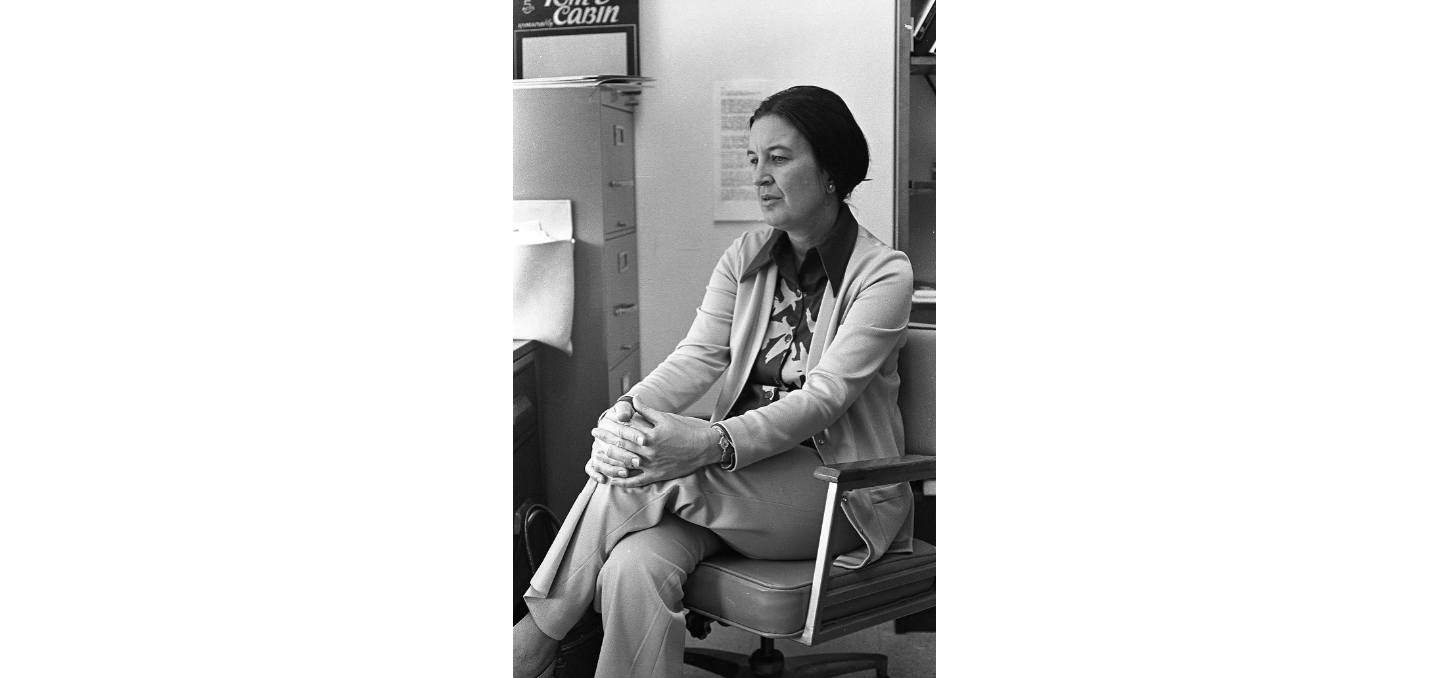
Figure 1. A portrait of Lorraine Brown, Professor of English, in 1974, four years after Mason’s administration sought to remove her. Broadside Photograph Collection, September 12, 1974.
Lorraine Brown began teaching in the English department at Mason in 1967, when she was still finishing her PhD at the University of Maryland. She convinced Mason’s administration to allow her to teach less than a full load—three classes instead of four—to balance teaching while finishing her dissertation. She also began her professorship as a single mother before she married Stephen J. Brown in 1969. He was also a Mason professor in the English department and served as an Associate Dean of the college from 1968 to 1970.1 Lorraine Brown was one of very few female faculty on campus amidst a largely male faculty-led college.
Lorraine Brown, Oral History Interview, 2002.
One can only imagine how difficult it was for Brown to navigate issues of gender and power on campus while also teaching, finishing her PhD, and being a single mother.
In early March of 1970, Brown received notice from Mason Chancellor Lorin Thompson that her appointment as an English professor would be terminated by June 30, 1971. The attempted removal was based on UVA’s anti-nepotism policy, which prohibited the hiring of a relative of an employee. Although Brown was already hired for two years as a professor before she married Stephen Brown, Thompson reported her teaching contract would still not be renewed and only UVA President Edgar Shannon had the authority to waive the policy at his discretion.
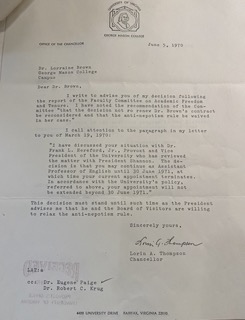
Figure 2. A letter from Chancellor Thompson to Lorraine Brown informing her that Mason’s Committee on Academic Freedom recommended waiving the anti-nepotism policy, but it was ultimately up to UVA President Shannon. Thompson to Brown correspondence, June 5, 1970. George Mason College General Records (Office of the Assistant Provost), University of Virginia Albert & Shirley Small Special Collections Library, Box 2, Folder GMC Faculty, General: 1971-1972.
Brown was not the only professor dismissed around this time. During the same semester, the teaching contracts of Professors William Tsow, in the history department, and Joerg Mayer, in the math department, were investigated based on “possible infringements of academic freedom and tenure.”2 Mayer resigned as head of the math department because he was informed that department chairs and tenured faculty are not “allowed to criticize the administration.”3 Tsow was relieved of his position because he proposed to teach a few advanced courses on “20th century East Asia” during the height of the controversial Vietnam War, though Dean Krug reported Tsow was dismissed due to his failure to “meet requirements of his contract.”4
Tsow and Mayer’s cases show the vulnerability of faculty who did not have tenure, which was a guaranteed permanent contract for academic professors. Both of these cases also demonstrate the limits of academic freedom, which was a protected right for all faculty members to express their own opinions without institutional censorship. Academic freedom was established in the U.S. by the Committee on Academic Freedom and Academic Tenure of the American Association of University Professors (AAUP). AAUP’s most widely accepted statement on academic freedom and tenure was published in 1940 in the middle of World War II, when many Americans were worried about institutional control over free speech due to the chilling example in Nazi Germany. But later in the 1960s, many American professors spoke out against the Vietnam war, such as Mason Professor James Shea and others, which tested the limits of academic freedom and made academic tenure even more difficult to attain.
This background suggests Brown’s position might have been investigated not because she was married to a coworker but possibly because she disagreed with and criticized the administration. The late 1960s was a tumultuous time of political disagreement throughout the country and on college campuses, especially about the issue of race, civil rights, and the Vietnam War. Many students and faculty protested their political beliefs at this time, especially in the center of campus on the quad, but this caused more tension with college administration.
Lorraine Brown, Oral History Interview, 2002.
Faculty and students not only protested the administration’s silence on Vietnam, but also their silence on racial inequity at Mason and in the United States. In the late 1960s, Mason’s campus was “very white” according to Brown, and practices on campus themselves, such as mock “slave sale” fundraising events, promoted a culture of racial ridicule and white supremacy.
Lorraine Brown, Oral History Interview, 2002.
In a town hall meeting on campus in May 1970 about the three faculty removals, Professor Brown asked Chancellor Thompson if she was dismissed because of her recent attempt to bring Upward Bound to campus and because of the self-study committee she established, both of which criticized the administration’s policies around race.5 Upward Bound was a federal program through the Department of Health, Education, and Welfare that helped disadvantaged students finish high school in a six-week program sponsored by local colleges. Brown was on the committee to bring the program to Mason’s campus in 1968, but they received pushback from Chancellor Thompson, which caused the program to ultimately not be established on campus. In 1970, Brown published an op-ed with the rest of the committee in the student newspaper Broadside criticizing Thompson’s unwillingness to start the program. They implied he did not want the program because most of the students who attended Upward Bound programs were African American students: “the fact that most of the students would be Negro may or may not have anything to do with the Chancellor’s reluctance.” Two days later, Thompson notified Brown about the college’s anti-nepotism policy and her subsequent dismissal.
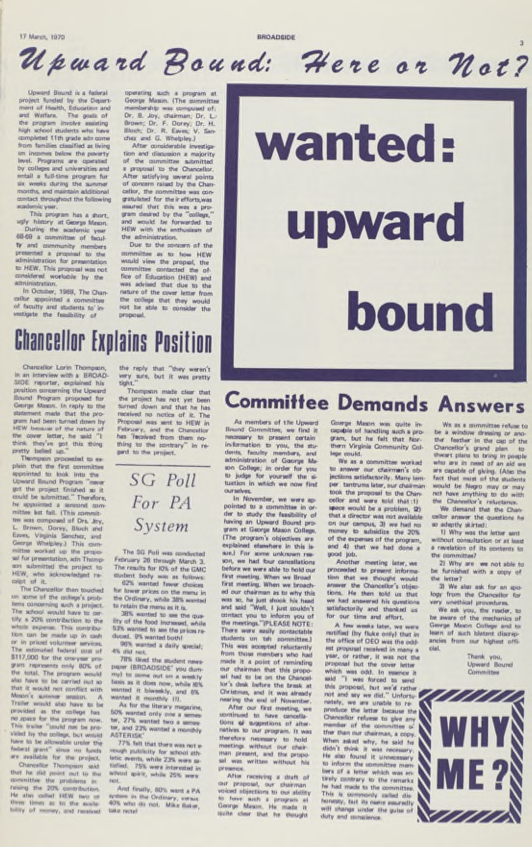
Figure 3. An op-ed published by Brown and the rest of the Upward Bound committee criticizing Chancellor Thompson’s reluctance to establish the program on campus. Broadside, March 17, 1970.
The self-study committee Brown established on campus was most likely a class on Black literature she recruited local Black students for in the late 1960s.6 Whether it was because of this class or not, the administration was clearly not happy about the different ways Brown pushed against the “very white” campus at Mason, like her colleagues Tsow and Mayer. Brown was critical of the administration in terms of race and civil liberties but also critical of the college in other ways. In 2002, she stated that there was “bad leadership” historically at Mason.
Lorraine Brown, Oral History Interview, 2002.
In 1970, the Committee on Academic Freedom reported the administration was “concern[ed]…[about] the professional competence of Professor L. Brown,” but their concern was most likely related to her tendency to speak out about Mason’s different institutional issues.7
Professor Brown’s contract was renewed by the fall semester in 1970, possibly in part because she served on the local branch of the American Association of University Professors. A handwritten memo on June 8, 1970, most likely written by an administrator at UVA stated: “The only case [out of the three faculty dismissals] that is likely to cause any consternation is the case of Lorraine Brown. I envision continued pressure at GMC on this case - perhaps further pressures from AAUP. I suspect that President Shannon will be requested to make a decision in this case.”
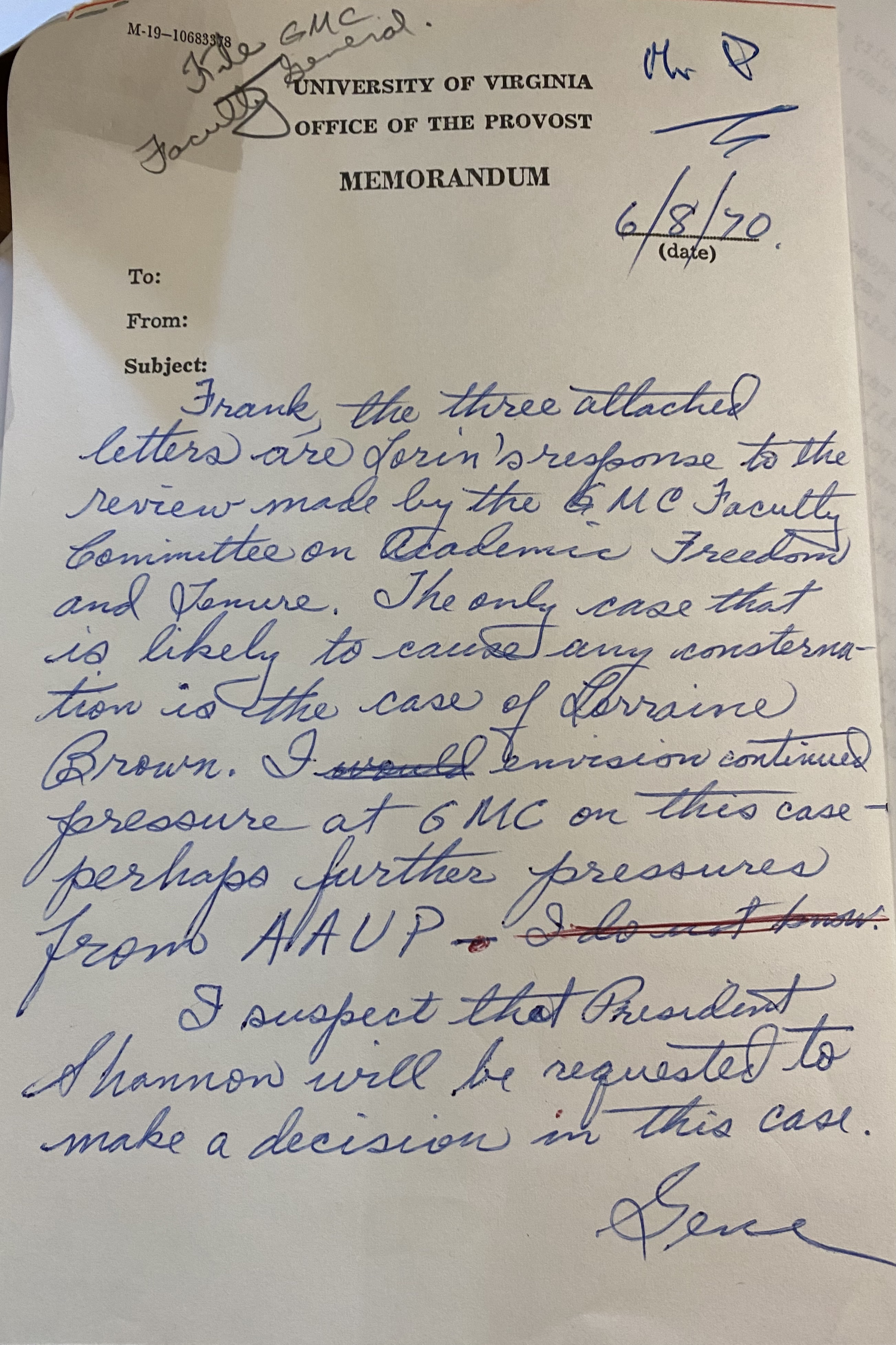
Figure 4. A handwritten memo from UVA’s Provost Office anticipating that UVA would receive “continued pressure at GMC” and from AAUP for Professor Brown to stay at Mason. Memo, June 8, 1970. George Mason College General Records (Office of the Assistant Provost, University of Virginia Albert & Shirley Small Special Collections Library, Box 2, Folder GMC Faculty, General: 1971-1972.
The fact that Brown served on the board of AAUP, a national organization built to protect the rights of faculty, most likely helped Mason’s Committee on Academic Freedom understand that the anti-nepotism policy was really an excuse to stifle Brown’s political activism on campus. The large-scale protest of Mason students also presumably helped Brown’s case. Shortly after news of Brown’s dismissal went public, a petition calling to renew Brown’s contract was signed by 740 students and delivered to administrators at both UVA and Mason.8 There were also numerous op-eds posted in Broadside by students who were upset with the administration’s attempt to remove Brown.
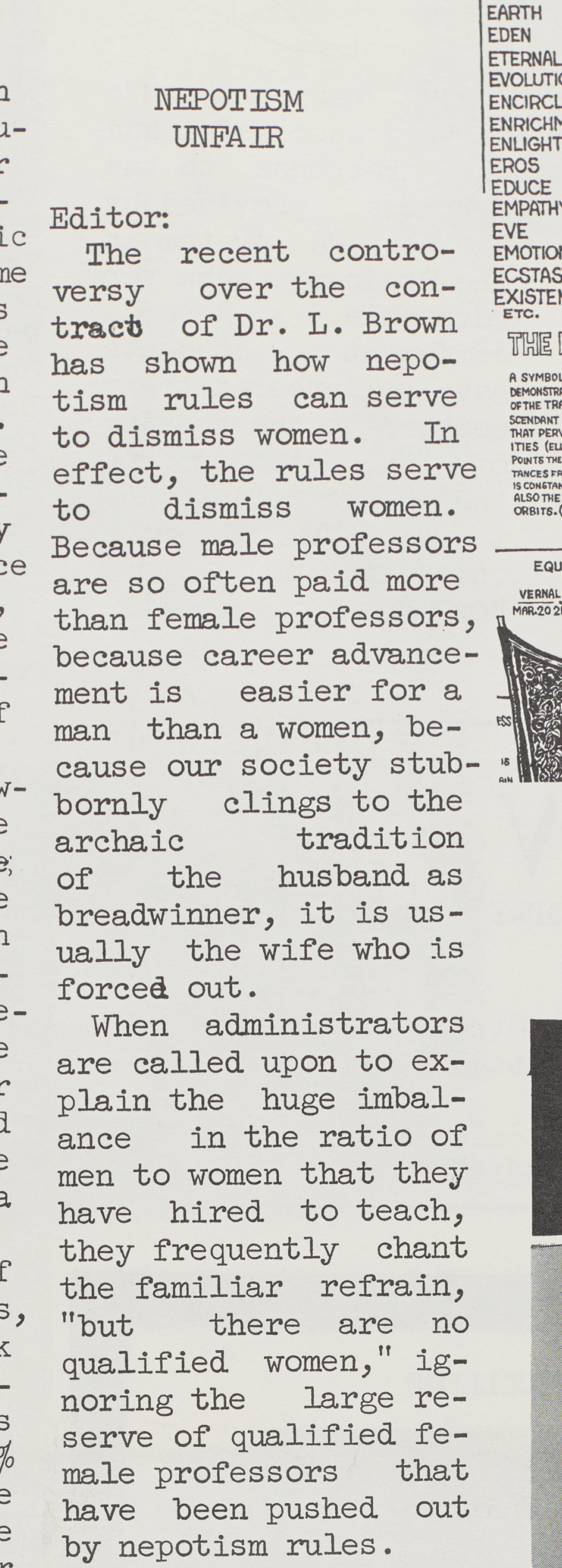
Figure 5. An excerpt of an op-ed published by a student, signed “feminist,” stating that the anti-nepotism policy was unfair to Professor Brown. Broadside, April 14, 1970.
In the end, Brown’s contract was renewed while her husband Stephen Brown stepped down as Associate Dean. Mayer resigned as chair of the math department, and Tsow left Mason. Lorraine Brown continued to enthusiastically teach literature and engage students for forty more years in the English department, which is today located in Horizon Hall. In 1973, she co-taught one of the first Mason courses in the field of Women’s Studies, “Women in Literature.”9 This set the foundation for academic exploration about women’s roles in history, society, and literature, eventually leading to the establishment of Mason’s Women’s Studies degree program by Brown and other Mason professors. The Women and Gender Studies program remains a strong department at Mason today. The department helped launch the Women’s Studies Center–located in the present day Johnson Center–which currently provides a space for students to connect and organize around gender-related issues. Professor Brown also contributed greatly to Mason’s library and archives through adding the Work Progress Administration’s Federal Theater Project collection in 1974 to Mason’s special collections, which is located in present day Fenwick Library’s Wing B & C. Simply put, Brown touched many parts of Mason’s present day campus in many ways. Through it all, she always valued her students and their education. In 2002, Professor Brown recalled “we still have a long way to go…and [need to do] the best that it can by the students and [put] them and their needs first…”
Lorraine Brown, Oral History Interview, 2002.
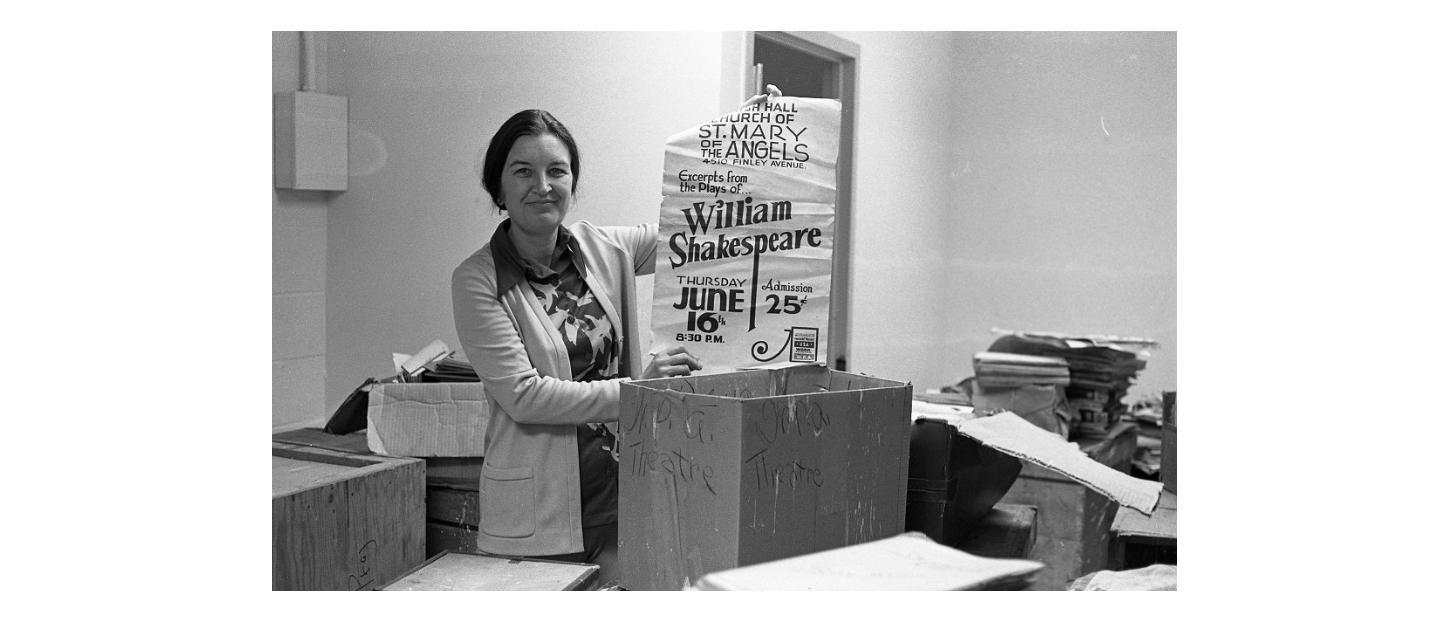
Figure 6. Professor Brown holds up a poster in 1974 from the Federal Theater Project collection. Broadside Photograph Collection, September 12, 1974.
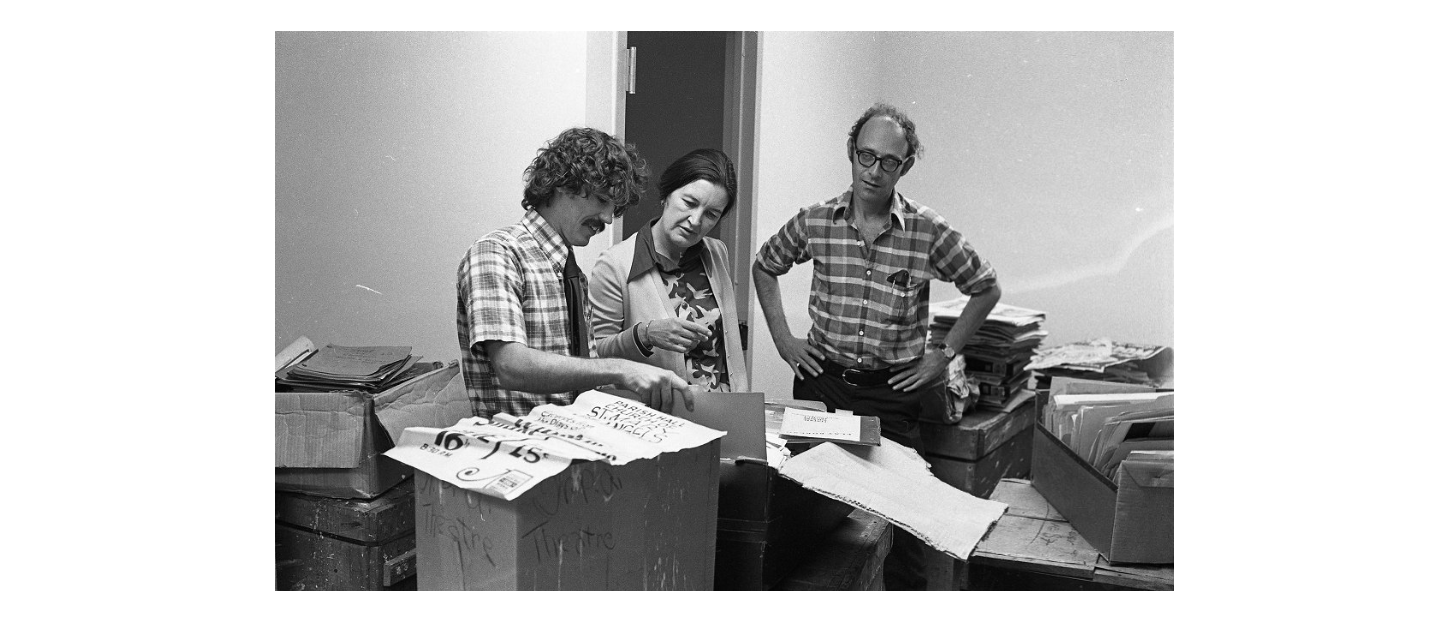
Figure 7. Professor Brown, with English Professor John O’Connor and Michael Sundell, looking through archival material related to the Federal Theater Project. Broadside Photograph Collection, September 12, 1974.
Laura Brannan Fretwell is a graduate research assistant at the Roy Rosenzweig Center for History and New Media and a History PhD candidate at George Mason University. She researches race, gender, and memory in the American South.
Suggested citation
Please use the following as a suggested citation:
Laura Brannan Fretwell, "Lorraine Brown: A Feminist Founder of George Mason," Mapping the University, Roy Rosenzweig Center for History and New Media, George Mason University (2022): <https://mappingtheuniversity.rrchnm.org/narratives/gmu-lorraine-brown/>.
The Washington Post, May 9, 1970. ↩︎
Ibid. ↩︎
Ibid. ↩︎
Broadside, April 14, 1970. Broadside, April 28, 1970. ↩︎
Broadside, May 12, 1970. ↩︎
Lorraine Brown, Oral History Interview, 2002. Special Collections Research Center, George Mason University. ↩︎
Melissa Stanley, June 1, 1970. George Mason College General Records (Office of the Assistant Provost), University of Virginia Albert & Shirley Small Special Collections Library, Box 2, Folder GMC Faculty, General: 1971-1972. ↩︎
Broadside, March 17, 1970. ↩︎
Northern Virginia Sun, February 28, 1973. ↩︎